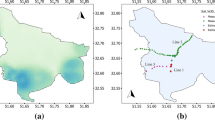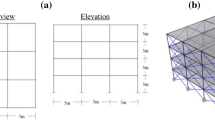Abstract
In this paper, we build an event-based seismic hazard assessment and financial analysis model for Hi-Tech Fabs in Taiwan. As we know, the low occurrence rate, tremendous loss and high uncertainty are characteristics of earthquake disasters. To handle the above issues, the model integrates knowledge from many fields including earth science, seismology, geology, risk management, structural engineering, the insurance profession, financial engineering and facility management. The portfolio of data from the site survey indicates that the model can be used to calculate the event losses (including buildings, contents and business interruption losses); furthermore the average annual loss and loss exceeding probabilities also can be calculated. The total earthquake risk cost, which includes earthquake insurance premiums, average annual retained loss and equivalent annual retrofit cost, is defined as an indicator for selection of optimal risk management strategies.







Similar content being viewed by others
References
Brian S, Stacy B (1999) Taiwan’s 921 quake and what it means to the semiconductor industry. http://www.semiconductorsafety.org/proceedings00/sherinbrian.pdf
Chen CW (2004) Stability analysis of T-S fuzzy models for nonlinear multiple time-delay interconnected systems. Math Comput Simul 66:523–537
Chen CW (2006) Stability conditions of fuzzy systems and its application to structural and mechanical systems. Adv Eng Softw 37:624–629
Chen CW (2009) Modeling and control for nonlinear structural systems via a NN-based approach. Exp Syst Appl 36:4765–4772
Chen CW (2010a) GA-based adaptive neural network controllers for nonlinear systems. Int J Innov Comput Inf Control 6:1793–1803
Chen CW (2010b) Stability analysis of an oceanic structure using the Lyapunov method. Eng Comput 27:186–204
Chen CW (2010c) Application of fuzzy-model-based control to nonlinear structural systems with time delay: an LMI method. J Vib Control 16:1651–1672
Chen CY (2010d) Fuzzy control for an oceanic structure: a case study in time-delay TLP system. J Vib Control 16:147–160
Chen CW (2011) Stability analysis and robustness design of nonlinear systems: an NN-based approach. Appl Soft Comput 11(2):2735–2742
Chen CW (2012a) A novel strategy to determine the insurance and risk control plan for natural disaster risk management. Nat Haz. doi:10.1007/s11069-012-0305-3
Chen CW (2012b) Hazard management and risk design by optimal statistical analysis. Nat Haz. doi:10.1007/s11069-012-0329-8
Chen CW (2012c) A new viewpoint of hazard assessment and management for Taiwan’s insurance issues”. Nat Haz. doi:10.1007/s11069-012-0363-6
Chen CY (2012d) Assessment of the major hazard potential of interfacial solitary waves moving over a trapezoidal obstacle on a horizontal plateau. Nat Haz 62(3):841–852
Chen CY (2012e) Disaster prevention and reduction for exploring teachers’ technology acceptance using a virtual reality system and partial least squares techniques. Nat Haz 62(3):1217–1231
Chen CW, Tseng CP (2012) Default risk-based probabilistic decision model for risk management and control. Nat Haz 63(2):659–671
Dong W (2001) Building a more profitable portfolio-modern portfolio theory with application to catastrophe insurance, risk management solutions. Euromoney Institutional Investor PLC
Erik R, Linus P (2003) Chi-Chi—three years on, global reinsurance
Gutenberg B, Richter CF (1991) Frequency of earthquake in California. Bull Seism Soc Am 34:185–188
Han PF, Ong M (2001) Risks in semiconductor fabrication plants, Singapore: Converium Ltd. http://www.converium.com/239.asp
Haque CE, Etkin D (2007) People and community as constituent parts of hazards: the significance of societal dimensions in hazards analysis. Nat Haz 41(2):271–282
Hsiao FH, Chen CW, Liang YW, Xu SD, Chiang WL (2005a) T-S fuzzy controllers for nonlinear interconnected systems with multiple time delays. IEEE Trans Circ Syst-I Regul Pap 52:1883–1893
Hsiao FH, Hwang JD, Chen CW, Tsai ZR (2005b) Robust stabilization of nonlinear multiple time-delay large-scale systems via decentralized fuzzy control. IEEE Trans Fuzzy Syst 13:152–163
Hsu WK (2011) An integrated flood risk assessment model for property insurance industry in Taiwan. Nat Haz 58(3):1295–1309
Hsu WK (2012a) Risk and uncertainty analysis in the planning stages of a risk decision-making process. Nat Haz 61(3):1355–1365
Hsu WK (2012b) A probabilistic approach for earthquake risk assessment based on an engineering insurance portfolio. Nat Haz. doi:10.1007/s11069-012-0425-9
Lauras M, Marques G, Gourc D (2010) Towards a multi-dimensional project performance measurement system. Decis Supp Syst 48:342–353
Lin ML (2011) Using GIS-based spatial geocomputation from remotely sensed data for drought risk-sensitive assessment. Int J Innov Comput Inf Control 7(2):657–668
Lin CW (2012a) The construction of a high-resolution visual monitoring for hazard analysis. Nat Haz. doi:10.1007/s11069-012-0409-9
Lin JW (2012b) Kalman filter decision systems for debris flow hazard assessment. Nat Haz 60(3):1255–1266
Lin JW (2012c) Modeling and assessment of bridge structure for seismic hazard prevention. Nat Haz 61(3):1115–1126
Lin JW (2012d) Potential hazard analysis and risk assessment of debris flow by fuzzy modeling. Nat Haz 64(1):273–282
Lin BS, Lee CT, Cheng CT (2002) Strong ground-motion attenuation relationship for subduction zone earthquakes in Taiwan. In: 9th Conference on geophysical society, China, pp 24–31
Ma K-F, Liu N-J (1997) Subduction slabs in Taiwan Region. J Geol China 40:653–670
Raaijmakers R, Krywkow J, van der Veen A (2008) Flood risk perceptions and spatial multi-criteria analysis: an exploratory research for hazard mitigation. Nat Haz 46(3):307–322
Risk Management Solutions (2000) Event report- Chi Chi, Taiwan earthquake
Shih BY (2012) Using Lego NXT to explore scientific literacy in disaster prevention and rescue systems. Nat Haz. doi:10.1007/s11069-012-0233-2
The World Bank & Columbia University (2005) Natural diaster hotspots—a global risk analysis. Hazard Management Unit, The World Bank, Washington
Tsai CH (2010) An earthquake disaster management mechanism based on risk assessment information for the tourism industry: a case study from the island of Taiwan. Tour Manag 31(4):470–481
Tsai CH (2011a) Development of a mechanism for typhoon and flood risk assessment and disaster management in the hotel industry: a case study of the Hualien area. Scand J Hospit Tour 11(3):324–341
Tsai CH (2011b) The establishment of a rapid natural disaster risk assessment model for the tourism industry. Tour Manag 32(1):158–171
Tsai CH, Chen CW (2010) An earthquake disaster management mechanism based on risk assessment information for the tourism industry: a case study from the island of Taiwan. Tour Manag 31(4):470–481
Tseng CP (2011) A new viewpoint on risk control decision models for natural disasters. Nat Haz 59(3):1715–1733
Tseng CP (2012) Natural disaster management mechanisms for probabilistic earthquake loss. Nat Haz 60(3):1055–1063
Tseng CP, Chen CW, Liu FR (2012a) Risk control allocation model for pressure vessels and piping project. J Vib Control 18(3):385–394
Tseng CP, Chang ML, Chen CW (2012b) Human factors of knowledge sharing intention among Taiwanese enterprises: a preliminary study. Hum Factors Ergon Manuf Serv Ind 22(4):328–339
Wang YP, Liao WH, Lee CL (2003) Seismic risks of typical double fabs in Taiwan’s hi-tech industry. In: Proceedings of the joint NCREE/JRC workshop international collaboration on earthquake disaster mitigation research, November 2003, pp 187–201
Werner SD, Taylor C, Moore J (1997) Loss estimation due to seismic risks to highway systems. Earthq Spectra 13(4):585–604
Yang HC (2012) Potential hazard analysis from the viewpoint of flow measurement in large open-channel junctions. Nat Haz 61(2):803–813
Zhou HJ, Wang JA, Wan JH et al (2010) Resilience to natural hazards: a geographic perspective. Nat Haz 53(1):21–41
Acknowledgments
The authors would like to thank the National Science Council of the Republic of China, Taiwan, for their financial support of this research under Contract Nos. 100-2221-E-022-013-MY2 and 100-2628-E-022-002-MY2.
Author information
Authors and Affiliations
Corresponding author
Rights and permissions
About this article
Cite this article
Hsu, WK., Chiang, WL. & Chen, CW. Earthquake risk assessment and optimal risk management strategies for Hi-Tech Fabs in Taiwan. Nat Hazards 65, 2063–2076 (2013). https://doi.org/10.1007/s11069-012-0462-4
Received:
Accepted:
Published:
Issue Date:
DOI: https://doi.org/10.1007/s11069-012-0462-4




